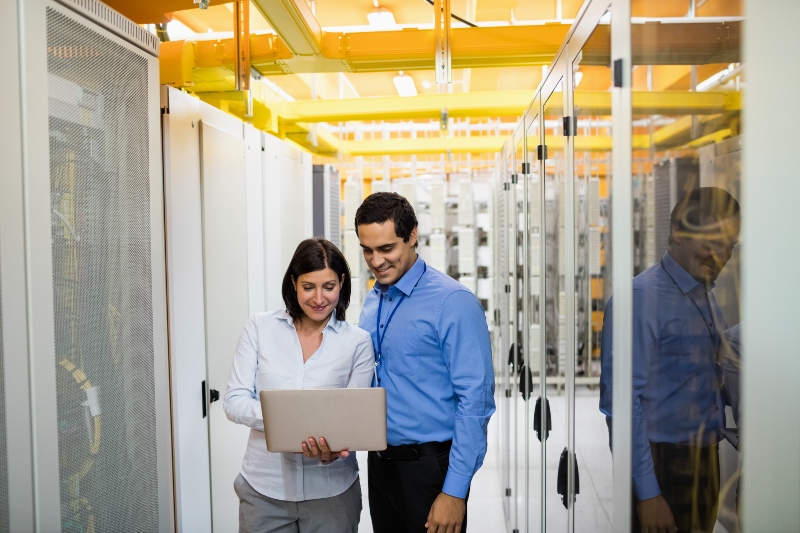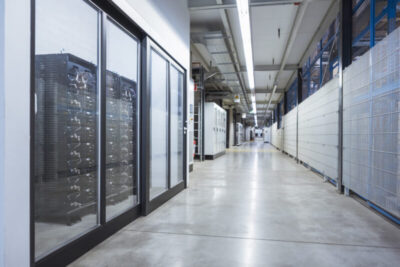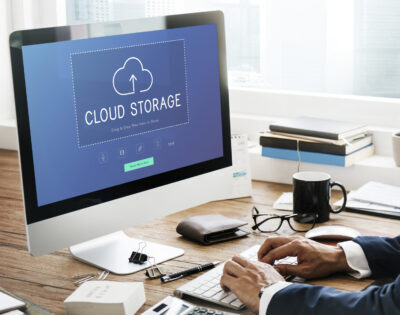
Data centers are necessary in our modern era since every organization has a growing arsenal of business-critical data. Even though data centers have been around for roughly 80 years, modern data centers are miles beyond the basics. In addition, they provide advanced security measures, uninterruptible power supplies (or readily available backup power), energy efficiency measures in place, and much more beyond simple and on-premises physical servers.
Selecting the best data center for your physical infrastructure and/or network infrastructure can be challenging but business-defining. However, there are many factors to consider that will influence your continual data storage. Some of these factors include the data center design, the security systems, and the dedicated cooling equipment or cooling units that power the data center facility.
From the data center infrastructure management to the power and cooling supply, organizations must ensure that every protective measure is in place before selecting a data center to provide storage services for the indefinite future.
Table of Contents
What is Data Center?
The Advancement of Modern Data Centers
Standards in Data Center Design
On-premises or Enterprise Data Centers
The Importance of Data Centers for Businesses
Solid Data Center Solutions with DartPoints
Data Center Solutions with DartPoints
DartPoints stands apart for our exceptional data center services, as well as our commitment to data center efficiency and customer service that is available 24/7/365. With storage options ranging from public and private clouds to physical data center facilities and advanced data center servers, we tailor all data center solutions to fit our customers’ precise needs.
In the meantime, it’s helpful to understand the foundational basics of data centers, from the storage infrastructure to the different services that a modern data center can provide. Read on to uncover the fundamentals of data centers, including how to ensure that your data center facility is the best option for your expanding business.
What is a data center?
A data center is a centralized physical facility that stores the core components of an organization’s critical applications and data. Simply put, it’s a physical site that contains all the computing infrastructure that an organization’s IT systems require, such as servers, data storage drives, and network infrastructure. Therefore, this data is accessible and protected from any security threats – from natural disasters to cyberattacks.
A quick background on data centers
Data centers technically began alongside the early computer systems of the 1940s, when computer hardware was complex, difficult to maintain, and generally required a single data center to house all the interworking parts. In these early days, data center operators had to connect these computing and storage systems with a mess of cables and hardware in a dedicated space (or dedicated data center), and power and cooling were required – and expensive – to protect the heavy machinery from overheating.
In these first years, and for many decades to come, individual companies invested in a single data center facility with their own guidelines for data center infrastructure management, and it was a costly and sometimes ineffective venture.
The Advancement of Modern Data Centers
Most folks have seen early 20th-century images of giant computers and storage devices taking up the bulk of a single room. However, the data center infrastructure of a modern data center looks nothing like its predecessors.
In fact, a modern data center is more advanced than the data centers of just a few years ago. That is because the needs have shifted from a focus on strictly physical infrastructure of multiple on-premises servers to a network that includes public and private clouds and their affiliated cloud data, and possibly other data centers. As a result, it’s now essential for a modern data center to be able to communicate across these multiple sites, at lightning speed and without interruption.
Because of this advancing complexity, organizations no longer have their own large data centers, and instead, seek out data center services, also known as managed services data centers. These data center resources provide all the intricacies of data center infrastructure, including cooling systems, physical security, support infrastructure, and even connections to a cloud services provider or other storage systems, all in a cost-effective manner.
The components of a data center
While every data center site can have a varying data center design, the basic components of a modern data center are the same. While there are different types of data centers, the data center infrastructure includes:
- cybersecurity systems
- routers, servers, storage systems (direct attached storage
- network attached storage
- firewalls switches
All of these listed are essential data center components.
Servers are arguably the most important data center components. They are vastly faster and more powerful processors than a typical high-performance computer. Storage devices such as hard-disk, solid-state, and robotic tape drives help data centers manage these servers, and servers are also partnered with communication and network equipment.
Standards in data center design
With the rise of data centers came new attention to data center security, as government agencies and other organizations required storage services for sensitive and critical data, leading to new regulations. As a result, the Telecommunications Industry Association (TIA) and the Uptime Institute adopted four data center tiers that cover all components of a data center design.
The four data center tiers are as follows:
Tier I
A Tier I data center is known as the most basic capacity level to support IT systems, and Tier 1 data centers are typically appropriate for an office or organizational setting. A sample of the requirements for a Tier I data center include:
- An uninterruptible power supply for power outages and spikes
- Data center physical infrastructure that is designed for IT systems
- Dedicated cooling equipment (such as air conditioning systems), that runs 24/7
- A backup power generator or power supply
Tier I data centers generally protect against service disruptions from human error but not against unexpected failure or outage. There is an average annual downtime of 29 hours in Tier I physical data centers.
Tier II
Tier II data center facilities provide additional cooling components within the data center’s physical infrastructure, including engine generators, chillers, cooling units, and/or pumps.
As the name suggests, Tier II data centers are a step above Tier 1 data centers. However, despite their more advanced cooling systems and other data center components, unexpected failures can still affect data center infrastructure. Tier II data centers tend to have an annual downtime of approximately 22 hours.
Tier III
Tier III data centers have more significant data redundant capacity components, and equipment can be replaced or maintained without a storage system shutdown. They also implement redundancy on other support systems like power and cooling systems and, as a result, have an average of only 1.6 hours of annual downtime.
Tier IV
Tier IV data centers contain several physically isolated systems which allow these data centers to avoid disruption from planned and unplanned events. They are completely fault-tolerant, have fully redundant capacity components, and have an average downtime of just 26 minutes each year.
Types of data centers and data center services
The growing complexity of data centers means that there are growing options when it comes to data center services. While exact services for an individual business or organization can vary widely, the types of data centers generally include the following.
Colocation data centers
Colocation data centers or colocation facilities are essentially large data center facilities where organizations can rent space to store their essential data center equipment servers, racks, and other computing hardware. The colocation data center facilities provide the storage infrastructure and the support infrastructure, as well as other imperative data center components such as physical security and cooling systems. In short, a colocation data center is a data center divided by multiple users.
Colocation facilities are a cost-effective option for most organizations, as the data center provides all of the essential infrastructure and services under varying service level agreements with multiple data center users.
On-premises or Enterprise data centers
On-premises or enterprise data centers are data centers that are owned and maintained by a singular company or organization.
The owner takes care of all the enterprise data center components, from physical security to cooling systems and power sources, and the data center is the responsibility of the company or organization alone. An enterprise data center is generally too costly for most businesses, so managed data center services through a data center provider is a much more widely used route for obtaining access to the best data center infrastructure available.
Hyperscale Data Centers
Hyperscale data centers provide the hyperscale computing that is necessary for cloud and big data storage. A hyperscale facility enables major cloud data providers to have access to scalable applications and storage services for their customers. These multiple data centers are usually at least 10,000 square feet in area. The main difference between a hyperscale data center and an enterprise data center is the high fiber network that is utilized across a hyperscale facility.
Cloud data centers
In a cloud data center, a customer can rent both space and data center infrastructure. The cloud data center takes care of all types of data infrastructure components. At the same time, the client accesses their data storage via different services that tend to offer flexibility in payments and usage.
Cloud data centers are arguably the most familiar type of data center options, and public cloud data providers include Amazon Web Services (AWS), Microsoft (Azure), and IBM Cloud. Cloud data centers are cost effective and free an organization from maintaining their equipment and hardware. Instead, the term data center handles all the maintenance and security components of the data center.
Keep in mind that there are different cloud data center options as well, such as public cloud, private cloud, and hybrid cloud. Effectively, a private cloud hosts all the data of a single company, while the public cloud has many users. Because there are so many different types of data centers – even when it comes to just cloud data centers – organizations need to explore their options carefully to find the best fit for their needs.
The Importance of Data Centers for Businesses
Multiple data centers may provide multiple services or different types of storage solutions. However, regardless of the best fit for a particular organization, a data center is essential for virtually every business for the following reasons.
Centralized and efficient data management
A key advantage of a data center is an organization’s ability to have central data management, as all files, applications, and general data are stored within one data center facility.
Room to grow
A data center also gives organizations the freedom to scale their operations up or down (and hopefully up) based on their growing needs. Clients who experience rapid growth or activity/demand during a particular timeframe can enhance their storage infrastructure with ease, without changing equipment, experiencing downtime, or building new data center infrastructure.
Better security
A top-rated data center offers the best security available, which is especially important for businesses that routinely work with sensitive data. A data center can also help organizations ensure they meet any industry regulations on security by having all protective measures in place automatically, such as biometric authentication, surveillance cameras, firewalls, and encryption.
Disaster recovery and redundancy
Data centers rely on redundant and multiple systems to ensure that data is always available, which makes them instrumental in case of an emergency. All data is also routinely backed up and available, so organizations can easily recover their essential information and applications in any worst-case scenario.
Saves money
In-house and on-premises data centers are simply no longer cost-effective. Even if a business can own and operate its own data center, the risks of downtime are inherently higher, and maintenance and operational costs are perpetual. A third-party data center provider eliminates all these costs while allowing organizations to have access to the best data center infrastructure available.
Solid Data Center Solutions with DartPoints
At DartPoints, we have multiple data centers that are strategically placed in mid-sized markets that need access to greater connectivity. We do everything in our power to ensure that our clients have the best reliability, availability, and security possible, so that their data is continuously protected and easily within reach.
Matched with 24/7/365 customer service and the most advanced technology available, DartPoints is an undisputed leader when it comes to data storage solutions. Reach out to us today to tell us about your data storage requirements now and well into the future, and we’ll work together to find the best solution for your unique business.





